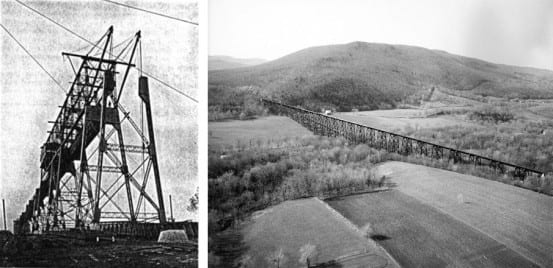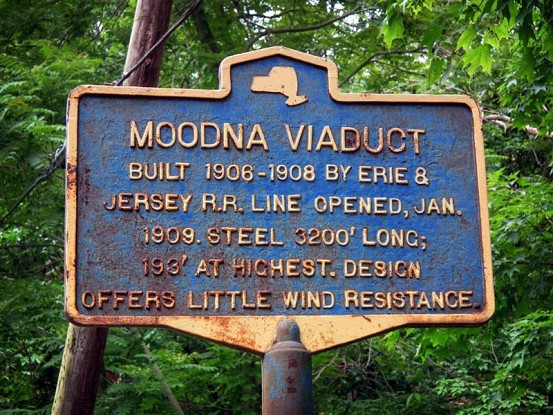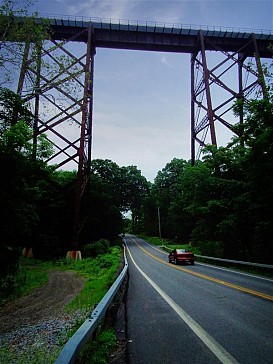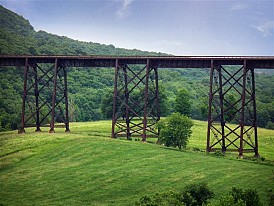
Early 20th century image of the Moodna Viaduct, from the Library of Congress
Quick, name one of the most picturesque locales on all of Metro-North. Most likely something along the Hudson Line pops into your mind. Sure, the Hudson River is gorgeous… but there just might be a lesser-known place that is definitely a beautiful sight, and certainly a contender for the aforementioned superlative. Most East of Hudson riders completely forget that Metro-North has two lines on the west side of the river – the Pascack Valley Line, and the Port Jervis Line. Neither of the two terminate at Grand Central, and although Metro-North owns the stations and subsidizes the line’s operations, the service is provided by New Jersey Transit. Along the Port Jervis line, you’ll find gorgeous rural countryside, even more so than the Upper Harlem. Heading towards Port Jervis, about 54.8 miles from Hoboken and 24.3 miles from Suffern, trains cross the picturesque Moodna Viaduct, which is undoubtedly one of the most attractive places in the Metro-North system. It was definitely one of my favorite places I’ve photographed for this blog thus far.

Left: Construction photograph of the Moodna Viaduct; Right: Library of Congress photograph of the Moodna Viaduct, 1971
The Moodna Viaduct (also known as the Moodna Creek Viaduct) was constructed by the Erie and Jersey Railroad and opened in 1909. The viaduct spans 3,200 feet, and is 196 feet above the ground at the highest point. The viaduct is the longest and tallest trestle east of the Mississippi River. The open design of the trestle, which minimizes wind resistance, has certainly stood the test of time – though Metro-North has made repairs to the viaduct in both 2007 and 2009. At the northern end of the trestle lies the Salisbury Mills-Cornwall station, and is approximately 32 miles before the end of the line at Port Jervis.



















Damnnnnn… I love that last image. Looks like I know where I’m buying a house someday, just to commute over that bridge every day.
If you don’t mind being sort of… in the middle of nowhere, it is really gorgeous over there. I’d love to go back too, I’ve seen some pretty awesome night photos of the viaduct.
Heh, I already live in the middle of nowhere…ten miles from the nearest commuter rail station, and an hour from Boston by train. Today, my directions somewhere included turning onto the first dirt road on the left after the collapsed barn. I tell my urban friends that they’ve reached my area when they see a tractor for sale on the side of the road.
You have no idea. The world-class sculpture garden is at the Bethlehem Art Gallery within a mile or so. The place is crawling with a great mix of artists, teachers, commuters, idiots, musicians, etc AND has some of the prime scenery in the northeast. I lived there as a kid and sorely miss it.
In short it is nothing LIKE the middle of nowhere. Itis the middle of a very sweet somewhere that has fortunately avoided being over-run
My uncle lives on the banks the Beaverdam Lake nearby (down the road from the Salisbury Mills train station, even though I’ve never gone by train yet) and it is always a treat to go up from NYC to visit him just to see that pretty scenery.
The Moodna Viaduct shows up in the background of an important scene in the film “Micheal Clayton” starring George Clooney. Great film, by the way. Check it out.
The words ” wind resistance” compells me to mention the collapse of the Tay Bridge in 1879 , the worst enginnering disaster in British history. The Tay Bridge spanned a wide estuary on the East Coast of Scotland and collasped when a ferocious gale struck the bridge when a passenger train was passing thru “the high girders”. Eighty passenegers perished.
I have recently aquired a well-researched book on the design and construction of the Tay bridge and the cause of the collaspe.
Very interesting photos and discussion of the bridge.
I’m impressed with the engineering of older bridges and surprised how many of them still carry traffic.
Too many of the older bridges have been torn down, but luckily a few remain to show us the skill of those builders.